The Role of Ecosystem Services in Climate Change Mitigation
VerifiedAdded on 2022/08/20
|20
|6571
|13
Project
AI Summary
This project delves into the critical role of ecosystem services and biodiversity in mitigating and adapting to climate change. It begins by establishing the interconnectedness of climate change, ecosystem services, and biodiversity, highlighting how climate change drives adaptations in species and ecosystems. The project examines the impacts of climate change on natural ecosystems and species, emphasizing the stresses on ecosystems and their ability to provide essential services like food, climate regulation, and cultural aspects. It explores the relationship between the United Nations Framework Convention on Climate Change (UNFCCC) and the Convention on Biological Diversity (CBD) in addressing climate change and biodiversity loss. The project investigates the role of ecosystems in the global carbon cycle and their importance for adaptation to climate change. It highlights the need for further research and action to reduce the impact of climate variations on biodiversity and to improve the interaction between biodiversity conservation and the ecological use of resources in relation to climate change mitigation and adaptation activities. The project includes a literature review that summarizes the current scientific understanding of the relationship between climate change, ecosystem services, and biodiversity, referencing international assessments and studies. The project concludes by summarizing the main points and emphasizing the importance of addressing climate change for sustainable development and human well-being.
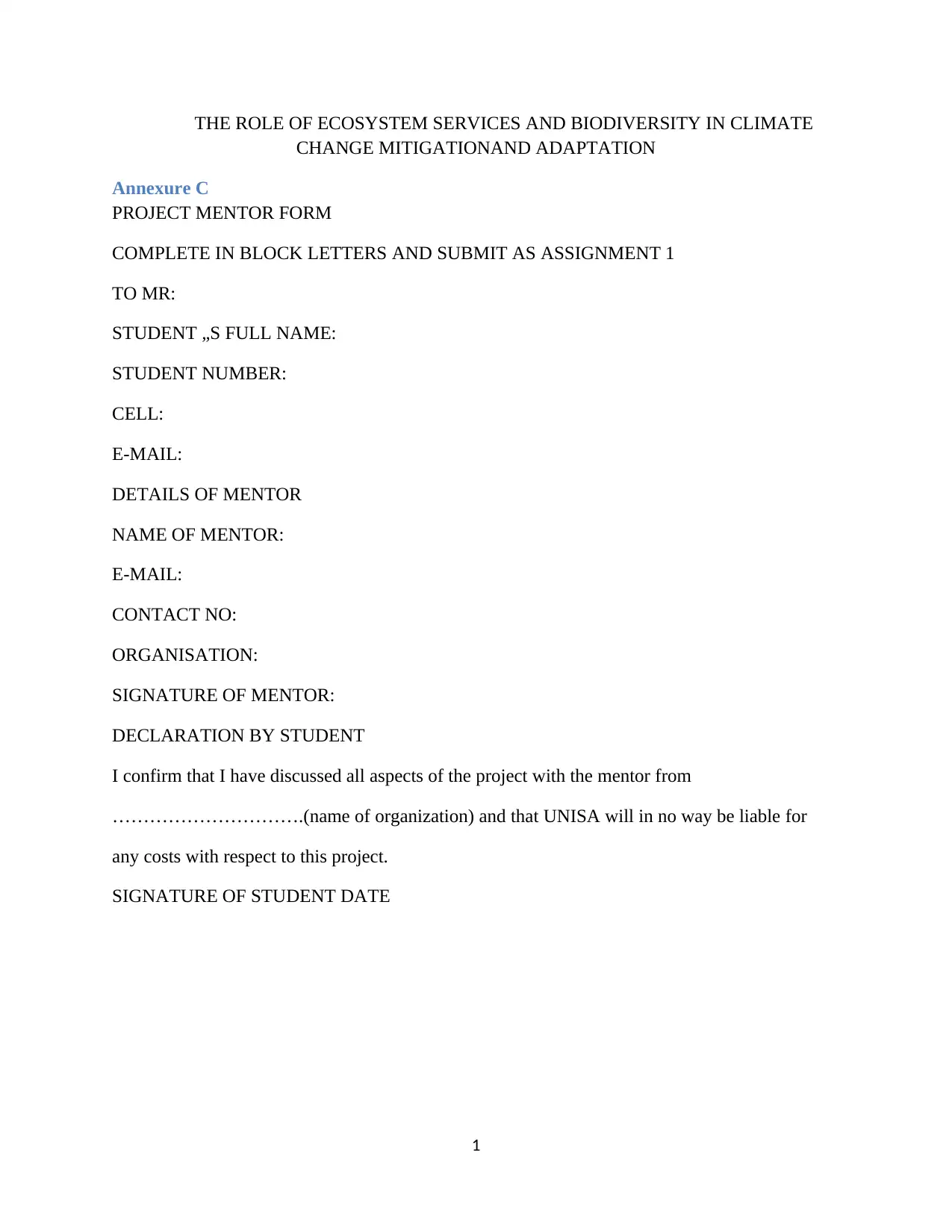
THE ROLE OF ECOSYSTEM SERVICES AND BIODIVERSITY IN CLIMATE
CHANGE MITIGATIONAND ADAPTATION
Annexure C
PROJECT MENTOR FORM
COMPLETE IN BLOCK LETTERS AND SUBMIT AS ASSIGNMENT 1
TO MR:
STUDENT „S FULL NAME:
STUDENT NUMBER:
CELL:
E-MAIL:
DETAILS OF MENTOR
NAME OF MENTOR:
E-MAIL:
CONTACT NO:
ORGANISATION:
SIGNATURE OF MENTOR:
DECLARATION BY STUDENT
I confirm that I have discussed all aspects of the project with the mentor from
………………………….(name of organization) and that UNISA will in no way be liable for
any costs with respect to this project.
SIGNATURE OF STUDENT DATE
1
CHANGE MITIGATIONAND ADAPTATION
Annexure C
PROJECT MENTOR FORM
COMPLETE IN BLOCK LETTERS AND SUBMIT AS ASSIGNMENT 1
TO MR:
STUDENT „S FULL NAME:
STUDENT NUMBER:
CELL:
E-MAIL:
DETAILS OF MENTOR
NAME OF MENTOR:
E-MAIL:
CONTACT NO:
ORGANISATION:
SIGNATURE OF MENTOR:
DECLARATION BY STUDENT
I confirm that I have discussed all aspects of the project with the mentor from
………………………….(name of organization) and that UNISA will in no way be liable for
any costs with respect to this project.
SIGNATURE OF STUDENT DATE
1
Paraphrase This Document
Need a fresh take? Get an instant paraphrase of this document with our AI Paraphraser

Annexure D
AFFIDAVIT
SUBMIT AS PART OF ASSIGNMENT 2
I ..................................................................................................Hereby declare that this project is
my own work.
MENTOR‟S SIGNATURE DATE
STUDENT NUMBER
CELL
E-MAIL
SIGNATURE OF STUDENT
PROJECT MENTOR COMMENTS ON STUDENT‟S FINAL PROJECT SUBMISSION TO
UNISA:
2
AFFIDAVIT
SUBMIT AS PART OF ASSIGNMENT 2
I ..................................................................................................Hereby declare that this project is
my own work.
MENTOR‟S SIGNATURE DATE
STUDENT NUMBER
CELL
SIGNATURE OF STUDENT
PROJECT MENTOR COMMENTS ON STUDENT‟S FINAL PROJECT SUBMISSION TO
UNISA:
2
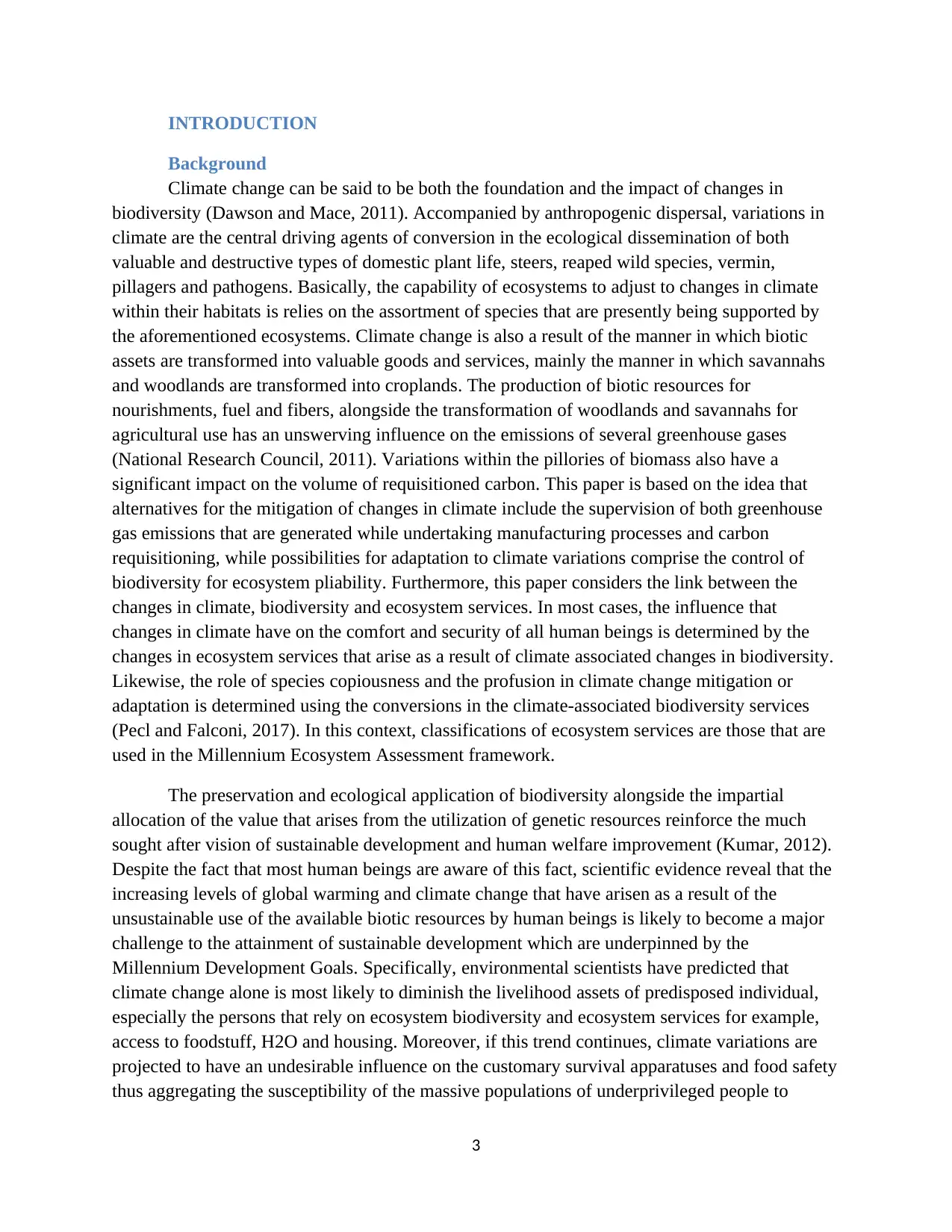
INTRODUCTION
Background
Climate change can be said to be both the foundation and the impact of changes in
biodiversity (Dawson and Mace, 2011). Accompanied by anthropogenic dispersal, variations in
climate are the central driving agents of conversion in the ecological dissemination of both
valuable and destructive types of domestic plant life, steers, reaped wild species, vermin,
pillagers and pathogens. Basically, the capability of ecosystems to adjust to changes in climate
within their habitats is relies on the assortment of species that are presently being supported by
the aforementioned ecosystems. Climate change is also a result of the manner in which biotic
assets are transformed into valuable goods and services, mainly the manner in which savannahs
and woodlands are transformed into croplands. The production of biotic resources for
nourishments, fuel and fibers, alongside the transformation of woodlands and savannahs for
agricultural use has an unswerving influence on the emissions of several greenhouse gases
(National Research Council, 2011). Variations within the pillories of biomass also have a
significant impact on the volume of requisitioned carbon. This paper is based on the idea that
alternatives for the mitigation of changes in climate include the supervision of both greenhouse
gas emissions that are generated while undertaking manufacturing processes and carbon
requisitioning, while possibilities for adaptation to climate variations comprise the control of
biodiversity for ecosystem pliability. Furthermore, this paper considers the link between the
changes in climate, biodiversity and ecosystem services. In most cases, the influence that
changes in climate have on the comfort and security of all human beings is determined by the
changes in ecosystem services that arise as a result of climate associated changes in biodiversity.
Likewise, the role of species copiousness and the profusion in climate change mitigation or
adaptation is determined using the conversions in the climate-associated biodiversity services
(Pecl and Falconi, 2017). In this context, classifications of ecosystem services are those that are
used in the Millennium Ecosystem Assessment framework.
The preservation and ecological application of biodiversity alongside the impartial
allocation of the value that arises from the utilization of genetic resources reinforce the much
sought after vision of sustainable development and human welfare improvement (Kumar, 2012).
Despite the fact that most human beings are aware of this fact, scientific evidence reveal that the
increasing levels of global warming and climate change that have arisen as a result of the
unsustainable use of the available biotic resources by human beings is likely to become a major
challenge to the attainment of sustainable development which are underpinned by the
Millennium Development Goals. Specifically, environmental scientists have predicted that
climate change alone is most likely to diminish the livelihood assets of predisposed individual,
especially the persons that rely on ecosystem biodiversity and ecosystem services for example,
access to foodstuff, H2O and housing. Moreover, if this trend continues, climate variations are
projected to have an undesirable influence on the customary survival apparatuses and food safety
thus aggregating the susceptibility of the massive populations of underprivileged people to
3
Background
Climate change can be said to be both the foundation and the impact of changes in
biodiversity (Dawson and Mace, 2011). Accompanied by anthropogenic dispersal, variations in
climate are the central driving agents of conversion in the ecological dissemination of both
valuable and destructive types of domestic plant life, steers, reaped wild species, vermin,
pillagers and pathogens. Basically, the capability of ecosystems to adjust to changes in climate
within their habitats is relies on the assortment of species that are presently being supported by
the aforementioned ecosystems. Climate change is also a result of the manner in which biotic
assets are transformed into valuable goods and services, mainly the manner in which savannahs
and woodlands are transformed into croplands. The production of biotic resources for
nourishments, fuel and fibers, alongside the transformation of woodlands and savannahs for
agricultural use has an unswerving influence on the emissions of several greenhouse gases
(National Research Council, 2011). Variations within the pillories of biomass also have a
significant impact on the volume of requisitioned carbon. This paper is based on the idea that
alternatives for the mitigation of changes in climate include the supervision of both greenhouse
gas emissions that are generated while undertaking manufacturing processes and carbon
requisitioning, while possibilities for adaptation to climate variations comprise the control of
biodiversity for ecosystem pliability. Furthermore, this paper considers the link between the
changes in climate, biodiversity and ecosystem services. In most cases, the influence that
changes in climate have on the comfort and security of all human beings is determined by the
changes in ecosystem services that arise as a result of climate associated changes in biodiversity.
Likewise, the role of species copiousness and the profusion in climate change mitigation or
adaptation is determined using the conversions in the climate-associated biodiversity services
(Pecl and Falconi, 2017). In this context, classifications of ecosystem services are those that are
used in the Millennium Ecosystem Assessment framework.
The preservation and ecological application of biodiversity alongside the impartial
allocation of the value that arises from the utilization of genetic resources reinforce the much
sought after vision of sustainable development and human welfare improvement (Kumar, 2012).
Despite the fact that most human beings are aware of this fact, scientific evidence reveal that the
increasing levels of global warming and climate change that have arisen as a result of the
unsustainable use of the available biotic resources by human beings is likely to become a major
challenge to the attainment of sustainable development which are underpinned by the
Millennium Development Goals. Specifically, environmental scientists have predicted that
climate change alone is most likely to diminish the livelihood assets of predisposed individual,
especially the persons that rely on ecosystem biodiversity and ecosystem services for example,
access to foodstuff, H2O and housing. Moreover, if this trend continues, climate variations are
projected to have an undesirable influence on the customary survival apparatuses and food safety
thus aggregating the susceptibility of the massive populations of underprivileged people to
3
⊘ This is a preview!⊘
Do you want full access?
Subscribe today to unlock all pages.

Trusted by 1+ million students worldwide
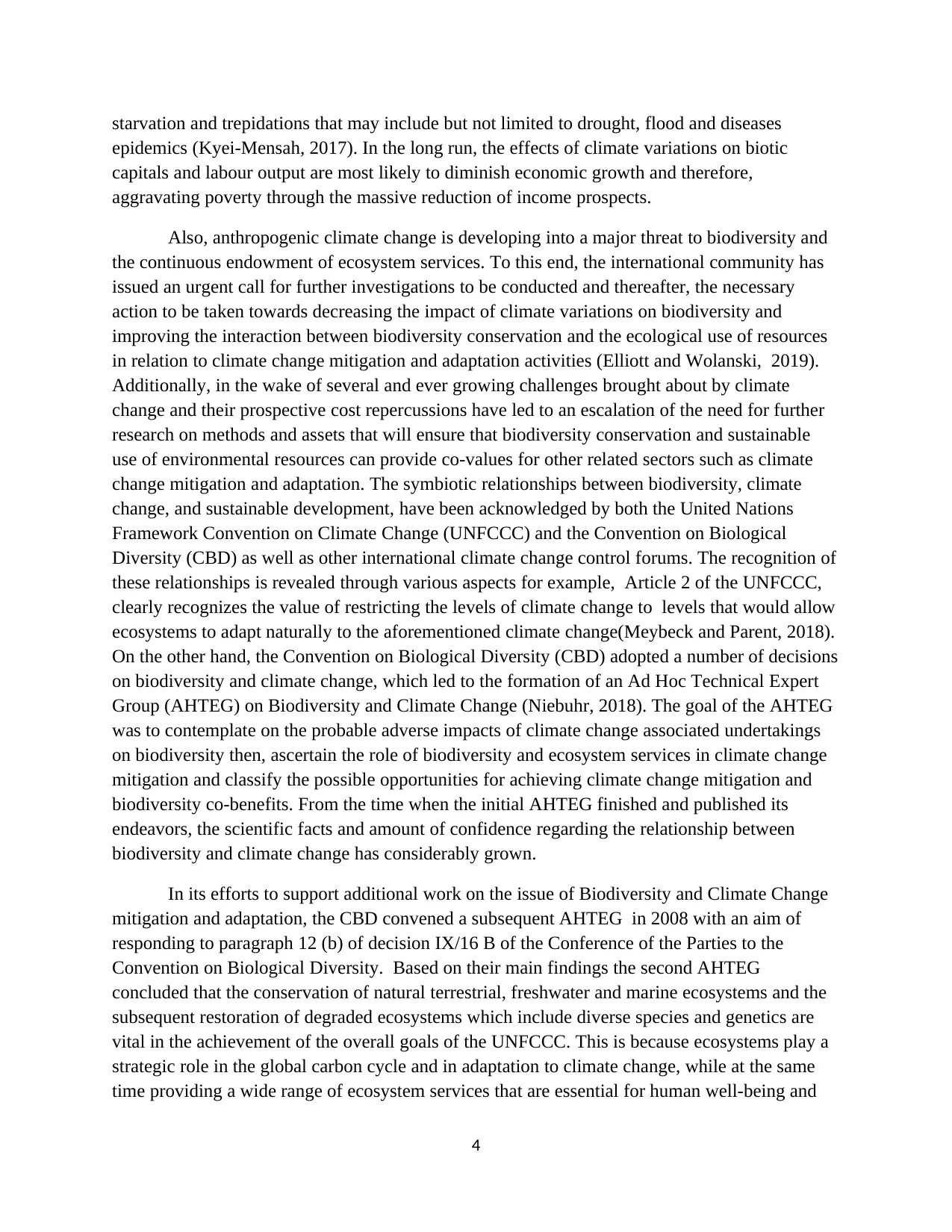
starvation and trepidations that may include but not limited to drought, flood and diseases
epidemics (Kyei-Mensah, 2017). In the long run, the effects of climate variations on biotic
capitals and labour output are most likely to diminish economic growth and therefore,
aggravating poverty through the massive reduction of income prospects.
Also, anthropogenic climate change is developing into a major threat to biodiversity and
the continuous endowment of ecosystem services. To this end, the international community has
issued an urgent call for further investigations to be conducted and thereafter, the necessary
action to be taken towards decreasing the impact of climate variations on biodiversity and
improving the interaction between biodiversity conservation and the ecological use of resources
in relation to climate change mitigation and adaptation activities (Elliott and Wolanski, 2019).
Additionally, in the wake of several and ever growing challenges brought about by climate
change and their prospective cost repercussions have led to an escalation of the need for further
research on methods and assets that will ensure that biodiversity conservation and sustainable
use of environmental resources can provide co-values for other related sectors such as climate
change mitigation and adaptation. The symbiotic relationships between biodiversity, climate
change, and sustainable development, have been acknowledged by both the United Nations
Framework Convention on Climate Change (UNFCCC) and the Convention on Biological
Diversity (CBD) as well as other international climate change control forums. The recognition of
these relationships is revealed through various aspects for example, Article 2 of the UNFCCC,
clearly recognizes the value of restricting the levels of climate change to levels that would allow
ecosystems to adapt naturally to the aforementioned climate change(Meybeck and Parent, 2018).
On the other hand, the Convention on Biological Diversity (CBD) adopted a number of decisions
on biodiversity and climate change, which led to the formation of an Ad Hoc Technical Expert
Group (AHTEG) on Biodiversity and Climate Change (Niebuhr, 2018). The goal of the AHTEG
was to contemplate on the probable adverse impacts of climate change associated undertakings
on biodiversity then, ascertain the role of biodiversity and ecosystem services in climate change
mitigation and classify the possible opportunities for achieving climate change mitigation and
biodiversity co-benefits. From the time when the initial AHTEG finished and published its
endeavors, the scientific facts and amount of confidence regarding the relationship between
biodiversity and climate change has considerably grown.
In its efforts to support additional work on the issue of Biodiversity and Climate Change
mitigation and adaptation, the CBD convened a subsequent AHTEG in 2008 with an aim of
responding to paragraph 12 (b) of decision IX/16 B of the Conference of the Parties to the
Convention on Biological Diversity. Based on their main findings the second AHTEG
concluded that the conservation of natural terrestrial, freshwater and marine ecosystems and the
subsequent restoration of degraded ecosystems which include diverse species and genetics are
vital in the achievement of the overall goals of the UNFCCC. This is because ecosystems play a
strategic role in the global carbon cycle and in adaptation to climate change, while at the same
time providing a wide range of ecosystem services that are essential for human well-being and
4
epidemics (Kyei-Mensah, 2017). In the long run, the effects of climate variations on biotic
capitals and labour output are most likely to diminish economic growth and therefore,
aggravating poverty through the massive reduction of income prospects.
Also, anthropogenic climate change is developing into a major threat to biodiversity and
the continuous endowment of ecosystem services. To this end, the international community has
issued an urgent call for further investigations to be conducted and thereafter, the necessary
action to be taken towards decreasing the impact of climate variations on biodiversity and
improving the interaction between biodiversity conservation and the ecological use of resources
in relation to climate change mitigation and adaptation activities (Elliott and Wolanski, 2019).
Additionally, in the wake of several and ever growing challenges brought about by climate
change and their prospective cost repercussions have led to an escalation of the need for further
research on methods and assets that will ensure that biodiversity conservation and sustainable
use of environmental resources can provide co-values for other related sectors such as climate
change mitigation and adaptation. The symbiotic relationships between biodiversity, climate
change, and sustainable development, have been acknowledged by both the United Nations
Framework Convention on Climate Change (UNFCCC) and the Convention on Biological
Diversity (CBD) as well as other international climate change control forums. The recognition of
these relationships is revealed through various aspects for example, Article 2 of the UNFCCC,
clearly recognizes the value of restricting the levels of climate change to levels that would allow
ecosystems to adapt naturally to the aforementioned climate change(Meybeck and Parent, 2018).
On the other hand, the Convention on Biological Diversity (CBD) adopted a number of decisions
on biodiversity and climate change, which led to the formation of an Ad Hoc Technical Expert
Group (AHTEG) on Biodiversity and Climate Change (Niebuhr, 2018). The goal of the AHTEG
was to contemplate on the probable adverse impacts of climate change associated undertakings
on biodiversity then, ascertain the role of biodiversity and ecosystem services in climate change
mitigation and classify the possible opportunities for achieving climate change mitigation and
biodiversity co-benefits. From the time when the initial AHTEG finished and published its
endeavors, the scientific facts and amount of confidence regarding the relationship between
biodiversity and climate change has considerably grown.
In its efforts to support additional work on the issue of Biodiversity and Climate Change
mitigation and adaptation, the CBD convened a subsequent AHTEG in 2008 with an aim of
responding to paragraph 12 (b) of decision IX/16 B of the Conference of the Parties to the
Convention on Biological Diversity. Based on their main findings the second AHTEG
concluded that the conservation of natural terrestrial, freshwater and marine ecosystems and the
subsequent restoration of degraded ecosystems which include diverse species and genetics are
vital in the achievement of the overall goals of the UNFCCC. This is because ecosystems play a
strategic role in the global carbon cycle and in adaptation to climate change, while at the same
time providing a wide range of ecosystem services that are essential for human well-being and
4
Paraphrase This Document
Need a fresh take? Get an instant paraphrase of this document with our AI Paraphraser
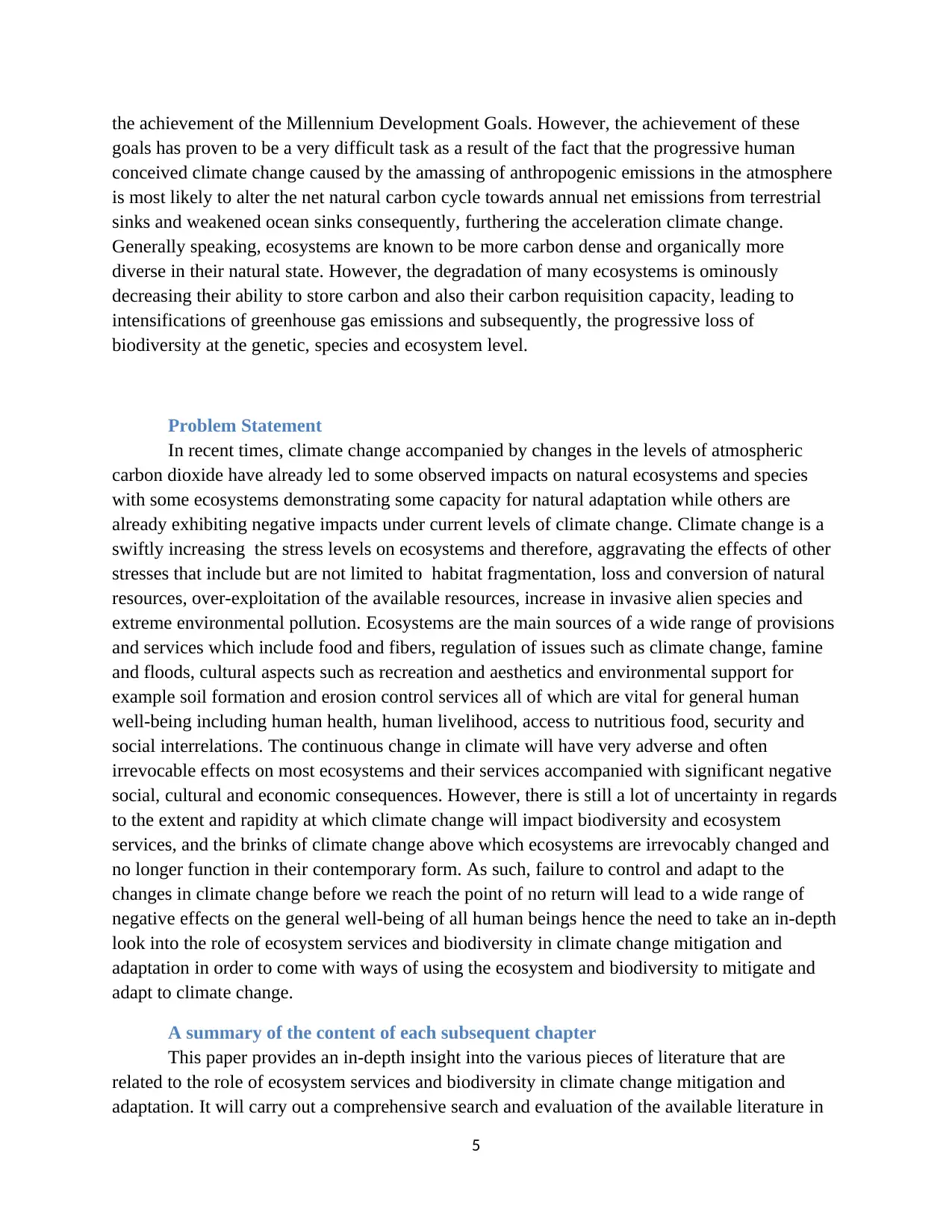
the achievement of the Millennium Development Goals. However, the achievement of these
goals has proven to be a very difficult task as a result of the fact that the progressive human
conceived climate change caused by the amassing of anthropogenic emissions in the atmosphere
is most likely to alter the net natural carbon cycle towards annual net emissions from terrestrial
sinks and weakened ocean sinks consequently, furthering the acceleration climate change.
Generally speaking, ecosystems are known to be more carbon dense and organically more
diverse in their natural state. However, the degradation of many ecosystems is ominously
decreasing their ability to store carbon and also their carbon requisition capacity, leading to
intensifications of greenhouse gas emissions and subsequently, the progressive loss of
biodiversity at the genetic, species and ecosystem level.
Problem Statement
In recent times, climate change accompanied by changes in the levels of atmospheric
carbon dioxide have already led to some observed impacts on natural ecosystems and species
with some ecosystems demonstrating some capacity for natural adaptation while others are
already exhibiting negative impacts under current levels of climate change. Climate change is a
swiftly increasing the stress levels on ecosystems and therefore, aggravating the effects of other
stresses that include but are not limited to habitat fragmentation, loss and conversion of natural
resources, over-exploitation of the available resources, increase in invasive alien species and
extreme environmental pollution. Ecosystems are the main sources of a wide range of provisions
and services which include food and fibers, regulation of issues such as climate change, famine
and floods, cultural aspects such as recreation and aesthetics and environmental support for
example soil formation and erosion control services all of which are vital for general human
well-being including human health, human livelihood, access to nutritious food, security and
social interrelations. The continuous change in climate will have very adverse and often
irrevocable effects on most ecosystems and their services accompanied with significant negative
social, cultural and economic consequences. However, there is still a lot of uncertainty in regards
to the extent and rapidity at which climate change will impact biodiversity and ecosystem
services, and the brinks of climate change above which ecosystems are irrevocably changed and
no longer function in their contemporary form. As such, failure to control and adapt to the
changes in climate change before we reach the point of no return will lead to a wide range of
negative effects on the general well-being of all human beings hence the need to take an in-depth
look into the role of ecosystem services and biodiversity in climate change mitigation and
adaptation in order to come with ways of using the ecosystem and biodiversity to mitigate and
adapt to climate change.
A summary of the content of each subsequent chapter
This paper provides an in-depth insight into the various pieces of literature that are
related to the role of ecosystem services and biodiversity in climate change mitigation and
adaptation. It will carry out a comprehensive search and evaluation of the available literature in
5
goals has proven to be a very difficult task as a result of the fact that the progressive human
conceived climate change caused by the amassing of anthropogenic emissions in the atmosphere
is most likely to alter the net natural carbon cycle towards annual net emissions from terrestrial
sinks and weakened ocean sinks consequently, furthering the acceleration climate change.
Generally speaking, ecosystems are known to be more carbon dense and organically more
diverse in their natural state. However, the degradation of many ecosystems is ominously
decreasing their ability to store carbon and also their carbon requisition capacity, leading to
intensifications of greenhouse gas emissions and subsequently, the progressive loss of
biodiversity at the genetic, species and ecosystem level.
Problem Statement
In recent times, climate change accompanied by changes in the levels of atmospheric
carbon dioxide have already led to some observed impacts on natural ecosystems and species
with some ecosystems demonstrating some capacity for natural adaptation while others are
already exhibiting negative impacts under current levels of climate change. Climate change is a
swiftly increasing the stress levels on ecosystems and therefore, aggravating the effects of other
stresses that include but are not limited to habitat fragmentation, loss and conversion of natural
resources, over-exploitation of the available resources, increase in invasive alien species and
extreme environmental pollution. Ecosystems are the main sources of a wide range of provisions
and services which include food and fibers, regulation of issues such as climate change, famine
and floods, cultural aspects such as recreation and aesthetics and environmental support for
example soil formation and erosion control services all of which are vital for general human
well-being including human health, human livelihood, access to nutritious food, security and
social interrelations. The continuous change in climate will have very adverse and often
irrevocable effects on most ecosystems and their services accompanied with significant negative
social, cultural and economic consequences. However, there is still a lot of uncertainty in regards
to the extent and rapidity at which climate change will impact biodiversity and ecosystem
services, and the brinks of climate change above which ecosystems are irrevocably changed and
no longer function in their contemporary form. As such, failure to control and adapt to the
changes in climate change before we reach the point of no return will lead to a wide range of
negative effects on the general well-being of all human beings hence the need to take an in-depth
look into the role of ecosystem services and biodiversity in climate change mitigation and
adaptation in order to come with ways of using the ecosystem and biodiversity to mitigate and
adapt to climate change.
A summary of the content of each subsequent chapter
This paper provides an in-depth insight into the various pieces of literature that are
related to the role of ecosystem services and biodiversity in climate change mitigation and
adaptation. It will carry out a comprehensive search and evaluation of the available literature in
5
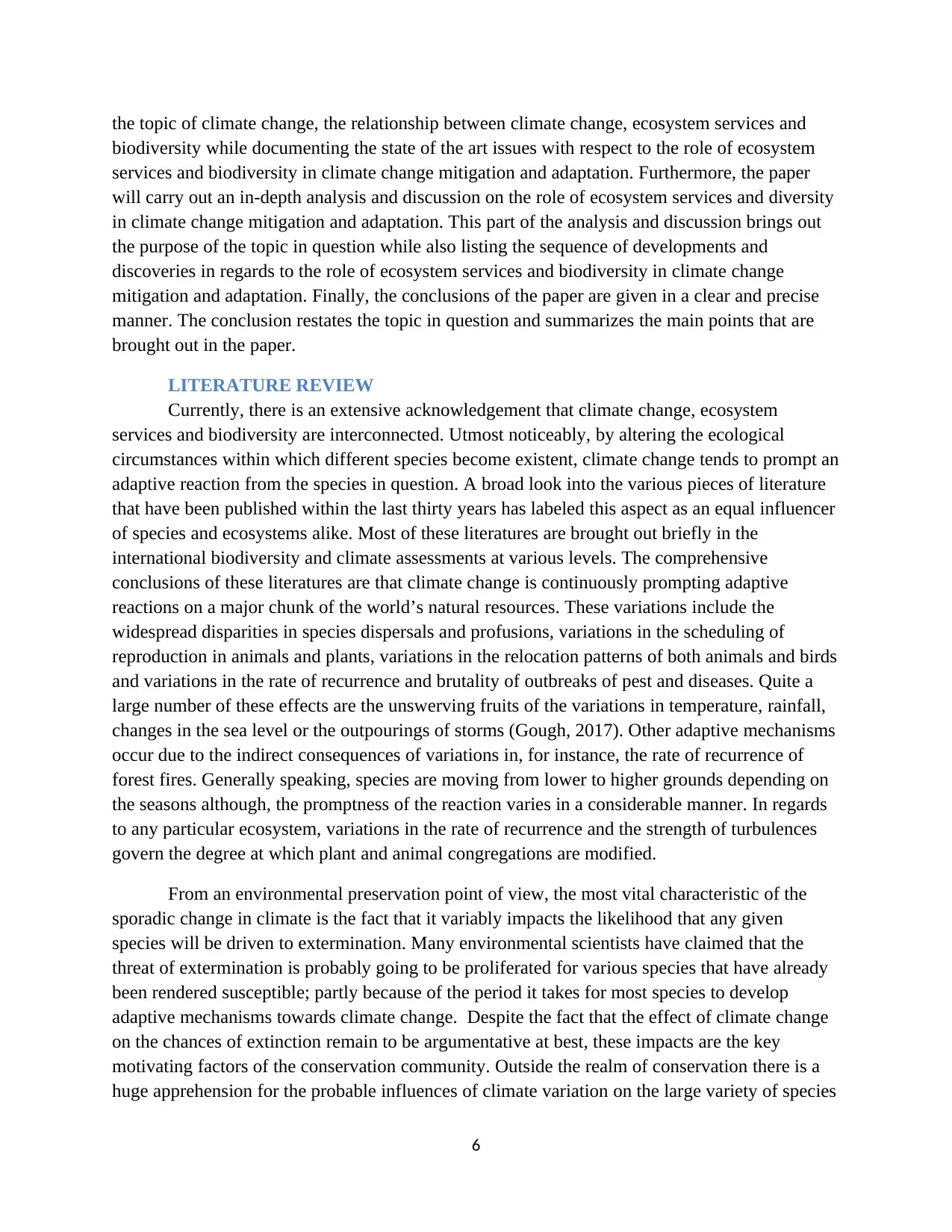
the topic of climate change, the relationship between climate change, ecosystem services and
biodiversity while documenting the state of the art issues with respect to the role of ecosystem
services and biodiversity in climate change mitigation and adaptation. Furthermore, the paper
will carry out an in-depth analysis and discussion on the role of ecosystem services and diversity
in climate change mitigation and adaptation. This part of the analysis and discussion brings out
the purpose of the topic in question while also listing the sequence of developments and
discoveries in regards to the role of ecosystem services and biodiversity in climate change
mitigation and adaptation. Finally, the conclusions of the paper are given in a clear and precise
manner. The conclusion restates the topic in question and summarizes the main points that are
brought out in the paper.
LITERATURE REVIEW
Currently, there is an extensive acknowledgement that climate change, ecosystem
services and biodiversity are interconnected. Utmost noticeably, by altering the ecological
circumstances within which different species become existent, climate change tends to prompt an
adaptive reaction from the species in question. A broad look into the various pieces of literature
that have been published within the last thirty years has labeled this aspect as an equal influencer
of species and ecosystems alike. Most of these literatures are brought out briefly in the
international biodiversity and climate assessments at various levels. The comprehensive
conclusions of these literatures are that climate change is continuously prompting adaptive
reactions on a major chunk of the world’s natural resources. These variations include the
widespread disparities in species dispersals and profusions, variations in the scheduling of
reproduction in animals and plants, variations in the relocation patterns of both animals and birds
and variations in the rate of recurrence and brutality of outbreaks of pest and diseases. Quite a
large number of these effects are the unswerving fruits of the variations in temperature, rainfall,
changes in the sea level or the outpourings of storms (Gough, 2017). Other adaptive mechanisms
occur due to the indirect consequences of variations in, for instance, the rate of recurrence of
forest fires. Generally speaking, species are moving from lower to higher grounds depending on
the seasons although, the promptness of the reaction varies in a considerable manner. In regards
to any particular ecosystem, variations in the rate of recurrence and the strength of turbulences
govern the degree at which plant and animal congregations are modified.
From an environmental preservation point of view, the most vital characteristic of the
sporadic change in climate is the fact that it variably impacts the likelihood that any given
species will be driven to extermination. Many environmental scientists have claimed that the
threat of extermination is probably going to be proliferated for various species that have already
been rendered susceptible; partly because of the period it takes for most species to develop
adaptive mechanisms towards climate change. Despite the fact that the effect of climate change
on the chances of extinction remain to be argumentative at best, these impacts are the key
motivating factors of the conservation community. Outside the realm of conservation there is a
huge apprehension for the probable influences of climate variation on the large variety of species
6
biodiversity while documenting the state of the art issues with respect to the role of ecosystem
services and biodiversity in climate change mitigation and adaptation. Furthermore, the paper
will carry out an in-depth analysis and discussion on the role of ecosystem services and diversity
in climate change mitigation and adaptation. This part of the analysis and discussion brings out
the purpose of the topic in question while also listing the sequence of developments and
discoveries in regards to the role of ecosystem services and biodiversity in climate change
mitigation and adaptation. Finally, the conclusions of the paper are given in a clear and precise
manner. The conclusion restates the topic in question and summarizes the main points that are
brought out in the paper.
LITERATURE REVIEW
Currently, there is an extensive acknowledgement that climate change, ecosystem
services and biodiversity are interconnected. Utmost noticeably, by altering the ecological
circumstances within which different species become existent, climate change tends to prompt an
adaptive reaction from the species in question. A broad look into the various pieces of literature
that have been published within the last thirty years has labeled this aspect as an equal influencer
of species and ecosystems alike. Most of these literatures are brought out briefly in the
international biodiversity and climate assessments at various levels. The comprehensive
conclusions of these literatures are that climate change is continuously prompting adaptive
reactions on a major chunk of the world’s natural resources. These variations include the
widespread disparities in species dispersals and profusions, variations in the scheduling of
reproduction in animals and plants, variations in the relocation patterns of both animals and birds
and variations in the rate of recurrence and brutality of outbreaks of pest and diseases. Quite a
large number of these effects are the unswerving fruits of the variations in temperature, rainfall,
changes in the sea level or the outpourings of storms (Gough, 2017). Other adaptive mechanisms
occur due to the indirect consequences of variations in, for instance, the rate of recurrence of
forest fires. Generally speaking, species are moving from lower to higher grounds depending on
the seasons although, the promptness of the reaction varies in a considerable manner. In regards
to any particular ecosystem, variations in the rate of recurrence and the strength of turbulences
govern the degree at which plant and animal congregations are modified.
From an environmental preservation point of view, the most vital characteristic of the
sporadic change in climate is the fact that it variably impacts the likelihood that any given
species will be driven to extermination. Many environmental scientists have claimed that the
threat of extermination is probably going to be proliferated for various species that have already
been rendered susceptible; partly because of the period it takes for most species to develop
adaptive mechanisms towards climate change. Despite the fact that the effect of climate change
on the chances of extinction remain to be argumentative at best, these impacts are the key
motivating factors of the conservation community. Outside the realm of conservation there is a
huge apprehension for the probable influences of climate variation on the large variety of species
6
⊘ This is a preview!⊘
Do you want full access?
Subscribe today to unlock all pages.

Trusted by 1+ million students worldwide
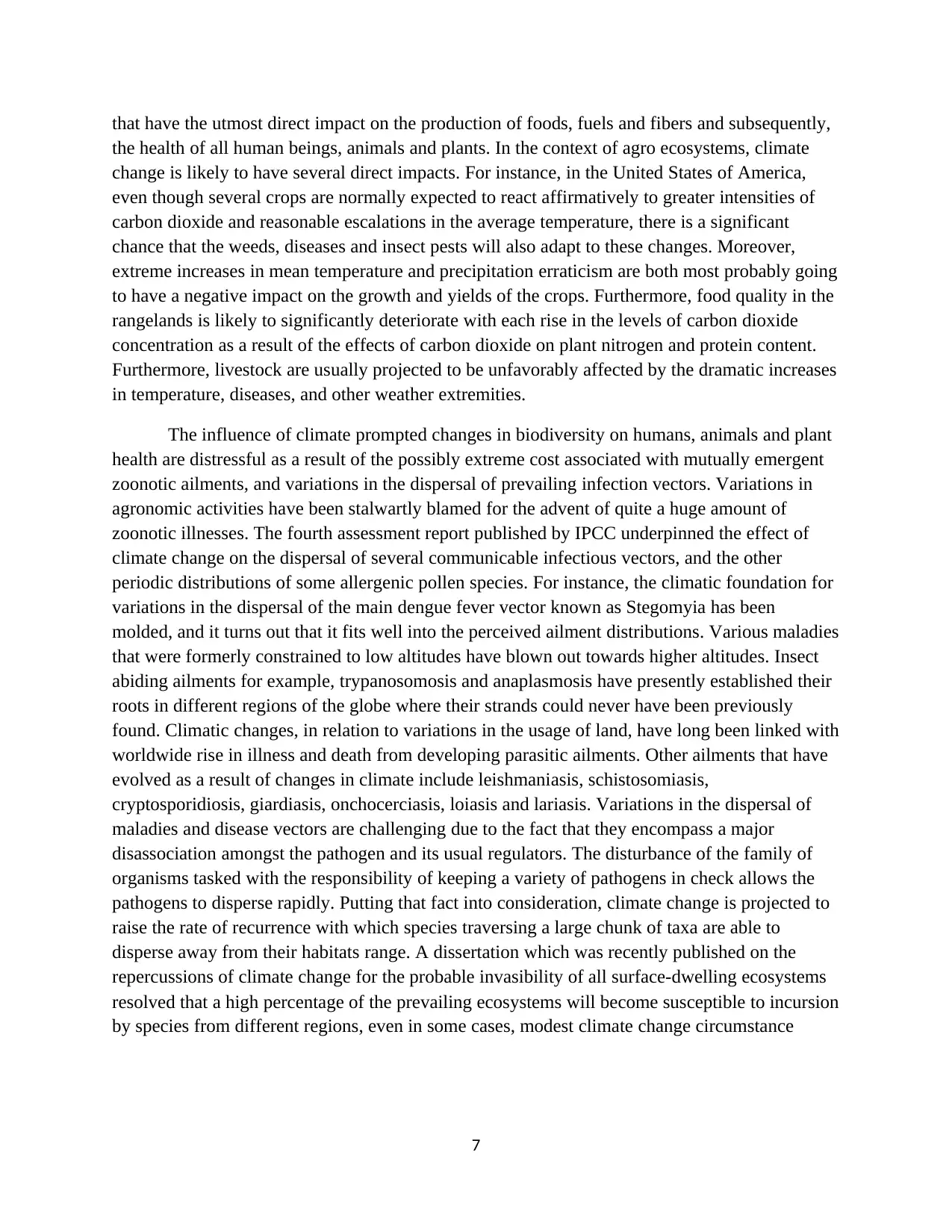
that have the utmost direct impact on the production of foods, fuels and fibers and subsequently,
the health of all human beings, animals and plants. In the context of agro ecosystems, climate
change is likely to have several direct impacts. For instance, in the United States of America,
even though several crops are normally expected to react affirmatively to greater intensities of
carbon dioxide and reasonable escalations in the average temperature, there is a significant
chance that the weeds, diseases and insect pests will also adapt to these changes. Moreover,
extreme increases in mean temperature and precipitation erraticism are both most probably going
to have a negative impact on the growth and yields of the crops. Furthermore, food quality in the
rangelands is likely to significantly deteriorate with each rise in the levels of carbon dioxide
concentration as a result of the effects of carbon dioxide on plant nitrogen and protein content.
Furthermore, livestock are usually projected to be unfavorably affected by the dramatic increases
in temperature, diseases, and other weather extremities.
The influence of climate prompted changes in biodiversity on humans, animals and plant
health are distressful as a result of the possibly extreme cost associated with mutually emergent
zoonotic ailments, and variations in the dispersal of prevailing infection vectors. Variations in
agronomic activities have been stalwartly blamed for the advent of quite a huge amount of
zoonotic illnesses. The fourth assessment report published by IPCC underpinned the effect of
climate change on the dispersal of several communicable infectious vectors, and the other
periodic distributions of some allergenic pollen species. For instance, the climatic foundation for
variations in the dispersal of the main dengue fever vector known as Stegomyia has been
molded, and it turns out that it fits well into the perceived ailment distributions. Various maladies
that were formerly constrained to low altitudes have blown out towards higher altitudes. Insect
abiding ailments for example, trypanosomosis and anaplasmosis have presently established their
roots in different regions of the globe where their strands could never have been previously
found. Climatic changes, in relation to variations in the usage of land, have long been linked with
worldwide rise in illness and death from developing parasitic ailments. Other ailments that have
evolved as a result of changes in climate include leishmaniasis, schistosomiasis,
cryptosporidiosis, giardiasis, onchocerciasis, loiasis and lariasis. Variations in the dispersal of
maladies and disease vectors are challenging due to the fact that they encompass a major
disassociation amongst the pathogen and its usual regulators. The disturbance of the family of
organisms tasked with the responsibility of keeping a variety of pathogens in check allows the
pathogens to disperse rapidly. Putting that fact into consideration, climate change is projected to
raise the rate of recurrence with which species traversing a large chunk of taxa are able to
disperse away from their habitats range. A dissertation which was recently published on the
repercussions of climate change for the probable invasibility of all surface-dwelling ecosystems
resolved that a high percentage of the prevailing ecosystems will become susceptible to incursion
by species from different regions, even in some cases, modest climate change circumstance
7
the health of all human beings, animals and plants. In the context of agro ecosystems, climate
change is likely to have several direct impacts. For instance, in the United States of America,
even though several crops are normally expected to react affirmatively to greater intensities of
carbon dioxide and reasonable escalations in the average temperature, there is a significant
chance that the weeds, diseases and insect pests will also adapt to these changes. Moreover,
extreme increases in mean temperature and precipitation erraticism are both most probably going
to have a negative impact on the growth and yields of the crops. Furthermore, food quality in the
rangelands is likely to significantly deteriorate with each rise in the levels of carbon dioxide
concentration as a result of the effects of carbon dioxide on plant nitrogen and protein content.
Furthermore, livestock are usually projected to be unfavorably affected by the dramatic increases
in temperature, diseases, and other weather extremities.
The influence of climate prompted changes in biodiversity on humans, animals and plant
health are distressful as a result of the possibly extreme cost associated with mutually emergent
zoonotic ailments, and variations in the dispersal of prevailing infection vectors. Variations in
agronomic activities have been stalwartly blamed for the advent of quite a huge amount of
zoonotic illnesses. The fourth assessment report published by IPCC underpinned the effect of
climate change on the dispersal of several communicable infectious vectors, and the other
periodic distributions of some allergenic pollen species. For instance, the climatic foundation for
variations in the dispersal of the main dengue fever vector known as Stegomyia has been
molded, and it turns out that it fits well into the perceived ailment distributions. Various maladies
that were formerly constrained to low altitudes have blown out towards higher altitudes. Insect
abiding ailments for example, trypanosomosis and anaplasmosis have presently established their
roots in different regions of the globe where their strands could never have been previously
found. Climatic changes, in relation to variations in the usage of land, have long been linked with
worldwide rise in illness and death from developing parasitic ailments. Other ailments that have
evolved as a result of changes in climate include leishmaniasis, schistosomiasis,
cryptosporidiosis, giardiasis, onchocerciasis, loiasis and lariasis. Variations in the dispersal of
maladies and disease vectors are challenging due to the fact that they encompass a major
disassociation amongst the pathogen and its usual regulators. The disturbance of the family of
organisms tasked with the responsibility of keeping a variety of pathogens in check allows the
pathogens to disperse rapidly. Putting that fact into consideration, climate change is projected to
raise the rate of recurrence with which species traversing a large chunk of taxa are able to
disperse away from their habitats range. A dissertation which was recently published on the
repercussions of climate change for the probable invasibility of all surface-dwelling ecosystems
resolved that a high percentage of the prevailing ecosystems will become susceptible to incursion
by species from different regions, even in some cases, modest climate change circumstance
7
Paraphrase This Document
Need a fresh take? Get an instant paraphrase of this document with our AI Paraphraser
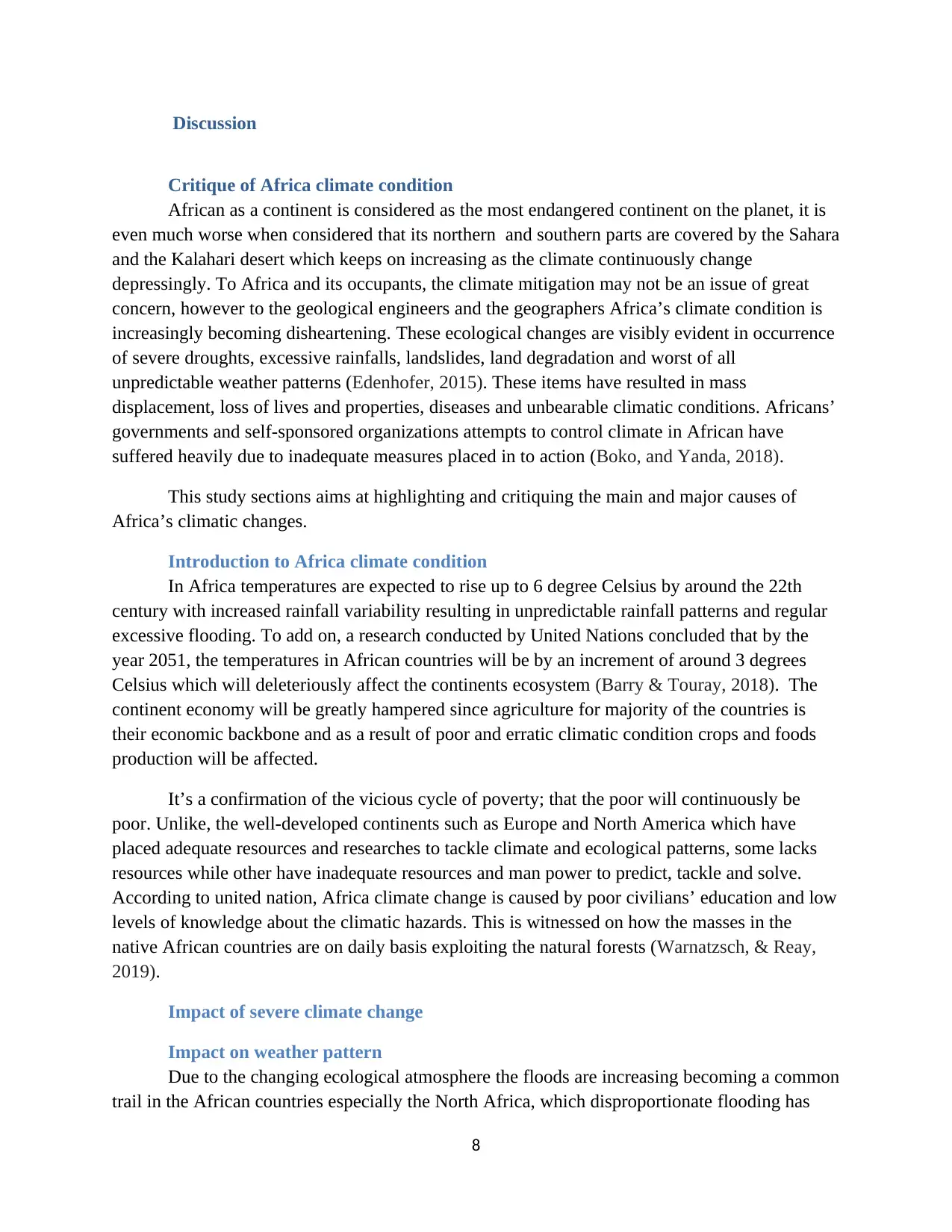
Discussion
Critique of Africa climate condition
African as a continent is considered as the most endangered continent on the planet, it is
even much worse when considered that its northern and southern parts are covered by the Sahara
and the Kalahari desert which keeps on increasing as the climate continuously change
depressingly. To Africa and its occupants, the climate mitigation may not be an issue of great
concern, however to the geological engineers and the geographers Africa’s climate condition is
increasingly becoming disheartening. These ecological changes are visibly evident in occurrence
of severe droughts, excessive rainfalls, landslides, land degradation and worst of all
unpredictable weather patterns (Edenhofer, 2015). These items have resulted in mass
displacement, loss of lives and properties, diseases and unbearable climatic conditions. Africans’
governments and self-sponsored organizations attempts to control climate in African have
suffered heavily due to inadequate measures placed in to action (Boko, and Yanda, 2018).
This study sections aims at highlighting and critiquing the main and major causes of
Africa’s climatic changes.
Introduction to Africa climate condition
In Africa temperatures are expected to rise up to 6 degree Celsius by around the 22th
century with increased rainfall variability resulting in unpredictable rainfall patterns and regular
excessive flooding. To add on, a research conducted by United Nations concluded that by the
year 2051, the temperatures in African countries will be by an increment of around 3 degrees
Celsius which will deleteriously affect the continents ecosystem (Barry & Touray, 2018). The
continent economy will be greatly hampered since agriculture for majority of the countries is
their economic backbone and as a result of poor and erratic climatic condition crops and foods
production will be affected.
It’s a confirmation of the vicious cycle of poverty; that the poor will continuously be
poor. Unlike, the well-developed continents such as Europe and North America which have
placed adequate resources and researches to tackle climate and ecological patterns, some lacks
resources while other have inadequate resources and man power to predict, tackle and solve.
According to united nation, Africa climate change is caused by poor civilians’ education and low
levels of knowledge about the climatic hazards. This is witnessed on how the masses in the
native African countries are on daily basis exploiting the natural forests (Warnatzsch, & Reay,
2019).
Impact of severe climate change
Impact on weather pattern
Due to the changing ecological atmosphere the floods are increasing becoming a common
trail in the African countries especially the North Africa, which disproportionate flooding has
8
Critique of Africa climate condition
African as a continent is considered as the most endangered continent on the planet, it is
even much worse when considered that its northern and southern parts are covered by the Sahara
and the Kalahari desert which keeps on increasing as the climate continuously change
depressingly. To Africa and its occupants, the climate mitigation may not be an issue of great
concern, however to the geological engineers and the geographers Africa’s climate condition is
increasingly becoming disheartening. These ecological changes are visibly evident in occurrence
of severe droughts, excessive rainfalls, landslides, land degradation and worst of all
unpredictable weather patterns (Edenhofer, 2015). These items have resulted in mass
displacement, loss of lives and properties, diseases and unbearable climatic conditions. Africans’
governments and self-sponsored organizations attempts to control climate in African have
suffered heavily due to inadequate measures placed in to action (Boko, and Yanda, 2018).
This study sections aims at highlighting and critiquing the main and major causes of
Africa’s climatic changes.
Introduction to Africa climate condition
In Africa temperatures are expected to rise up to 6 degree Celsius by around the 22th
century with increased rainfall variability resulting in unpredictable rainfall patterns and regular
excessive flooding. To add on, a research conducted by United Nations concluded that by the
year 2051, the temperatures in African countries will be by an increment of around 3 degrees
Celsius which will deleteriously affect the continents ecosystem (Barry & Touray, 2018). The
continent economy will be greatly hampered since agriculture for majority of the countries is
their economic backbone and as a result of poor and erratic climatic condition crops and foods
production will be affected.
It’s a confirmation of the vicious cycle of poverty; that the poor will continuously be
poor. Unlike, the well-developed continents such as Europe and North America which have
placed adequate resources and researches to tackle climate and ecological patterns, some lacks
resources while other have inadequate resources and man power to predict, tackle and solve.
According to united nation, Africa climate change is caused by poor civilians’ education and low
levels of knowledge about the climatic hazards. This is witnessed on how the masses in the
native African countries are on daily basis exploiting the natural forests (Warnatzsch, & Reay,
2019).
Impact of severe climate change
Impact on weather pattern
Due to the changing ecological atmosphere the floods are increasing becoming a common
trail in the African countries especially the North Africa, which disproportionate flooding has
8
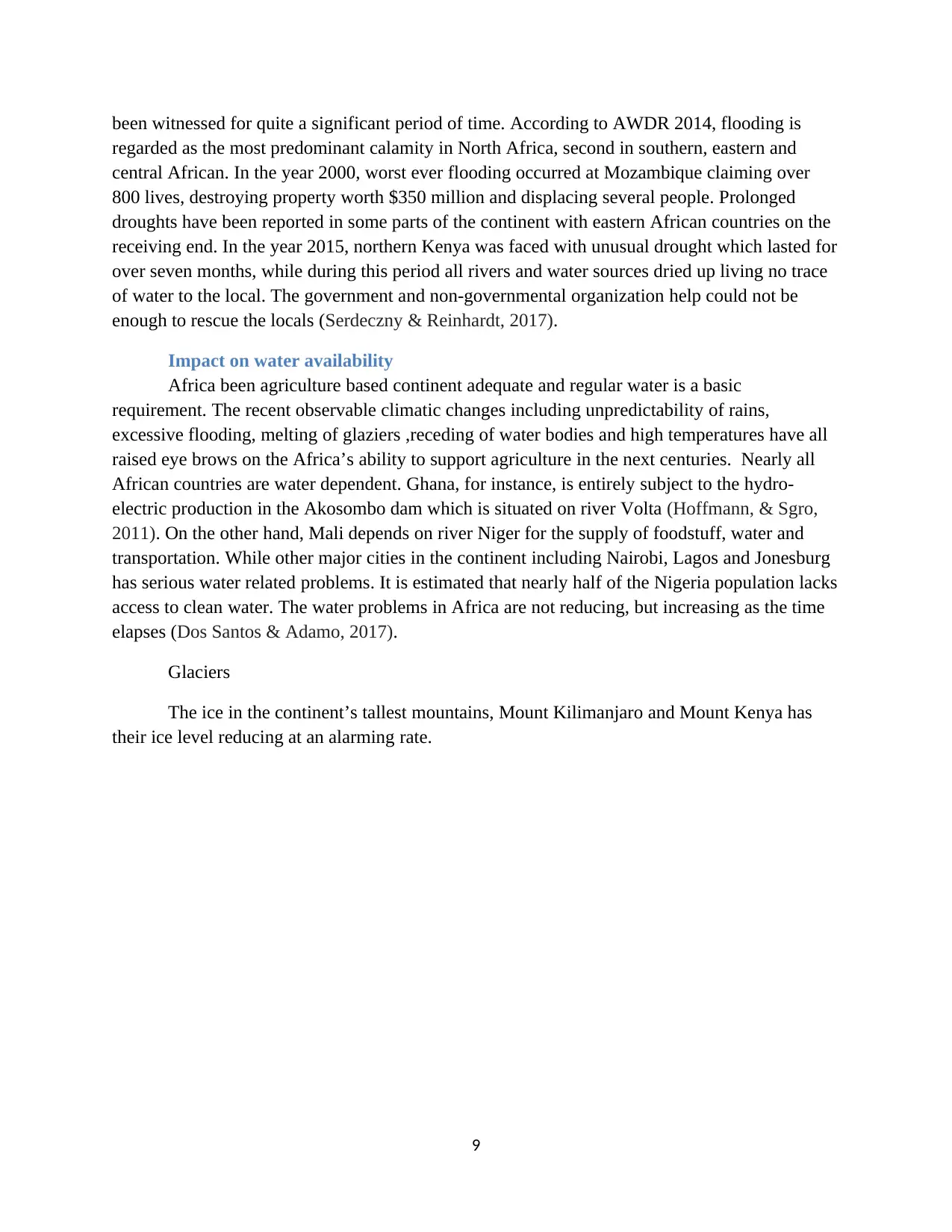
been witnessed for quite a significant period of time. According to AWDR 2014, flooding is
regarded as the most predominant calamity in North Africa, second in southern, eastern and
central African. In the year 2000, worst ever flooding occurred at Mozambique claiming over
800 lives, destroying property worth $350 million and displacing several people. Prolonged
droughts have been reported in some parts of the continent with eastern African countries on the
receiving end. In the year 2015, northern Kenya was faced with unusual drought which lasted for
over seven months, while during this period all rivers and water sources dried up living no trace
of water to the local. The government and non-governmental organization help could not be
enough to rescue the locals (Serdeczny & Reinhardt, 2017).
Impact on water availability
Africa been agriculture based continent adequate and regular water is a basic
requirement. The recent observable climatic changes including unpredictability of rains,
excessive flooding, melting of glaziers ,receding of water bodies and high temperatures have all
raised eye brows on the Africa’s ability to support agriculture in the next centuries. Nearly all
African countries are water dependent. Ghana, for instance, is entirely subject to the hydro-
electric production in the Akosombo dam which is situated on river Volta (Hoffmann, & Sgro,
2011). On the other hand, Mali depends on river Niger for the supply of foodstuff, water and
transportation. While other major cities in the continent including Nairobi, Lagos and Jonesburg
has serious water related problems. It is estimated that nearly half of the Nigeria population lacks
access to clean water. The water problems in Africa are not reducing, but increasing as the time
elapses (Dos Santos & Adamo, 2017).
Glaciers
The ice in the continent’s tallest mountains, Mount Kilimanjaro and Mount Kenya has
their ice level reducing at an alarming rate.
9
regarded as the most predominant calamity in North Africa, second in southern, eastern and
central African. In the year 2000, worst ever flooding occurred at Mozambique claiming over
800 lives, destroying property worth $350 million and displacing several people. Prolonged
droughts have been reported in some parts of the continent with eastern African countries on the
receiving end. In the year 2015, northern Kenya was faced with unusual drought which lasted for
over seven months, while during this period all rivers and water sources dried up living no trace
of water to the local. The government and non-governmental organization help could not be
enough to rescue the locals (Serdeczny & Reinhardt, 2017).
Impact on water availability
Africa been agriculture based continent adequate and regular water is a basic
requirement. The recent observable climatic changes including unpredictability of rains,
excessive flooding, melting of glaziers ,receding of water bodies and high temperatures have all
raised eye brows on the Africa’s ability to support agriculture in the next centuries. Nearly all
African countries are water dependent. Ghana, for instance, is entirely subject to the hydro-
electric production in the Akosombo dam which is situated on river Volta (Hoffmann, & Sgro,
2011). On the other hand, Mali depends on river Niger for the supply of foodstuff, water and
transportation. While other major cities in the continent including Nairobi, Lagos and Jonesburg
has serious water related problems. It is estimated that nearly half of the Nigeria population lacks
access to clean water. The water problems in Africa are not reducing, but increasing as the time
elapses (Dos Santos & Adamo, 2017).
Glaciers
The ice in the continent’s tallest mountains, Mount Kilimanjaro and Mount Kenya has
their ice level reducing at an alarming rate.
9
⊘ This is a preview!⊘
Do you want full access?
Subscribe today to unlock all pages.

Trusted by 1+ million students worldwide
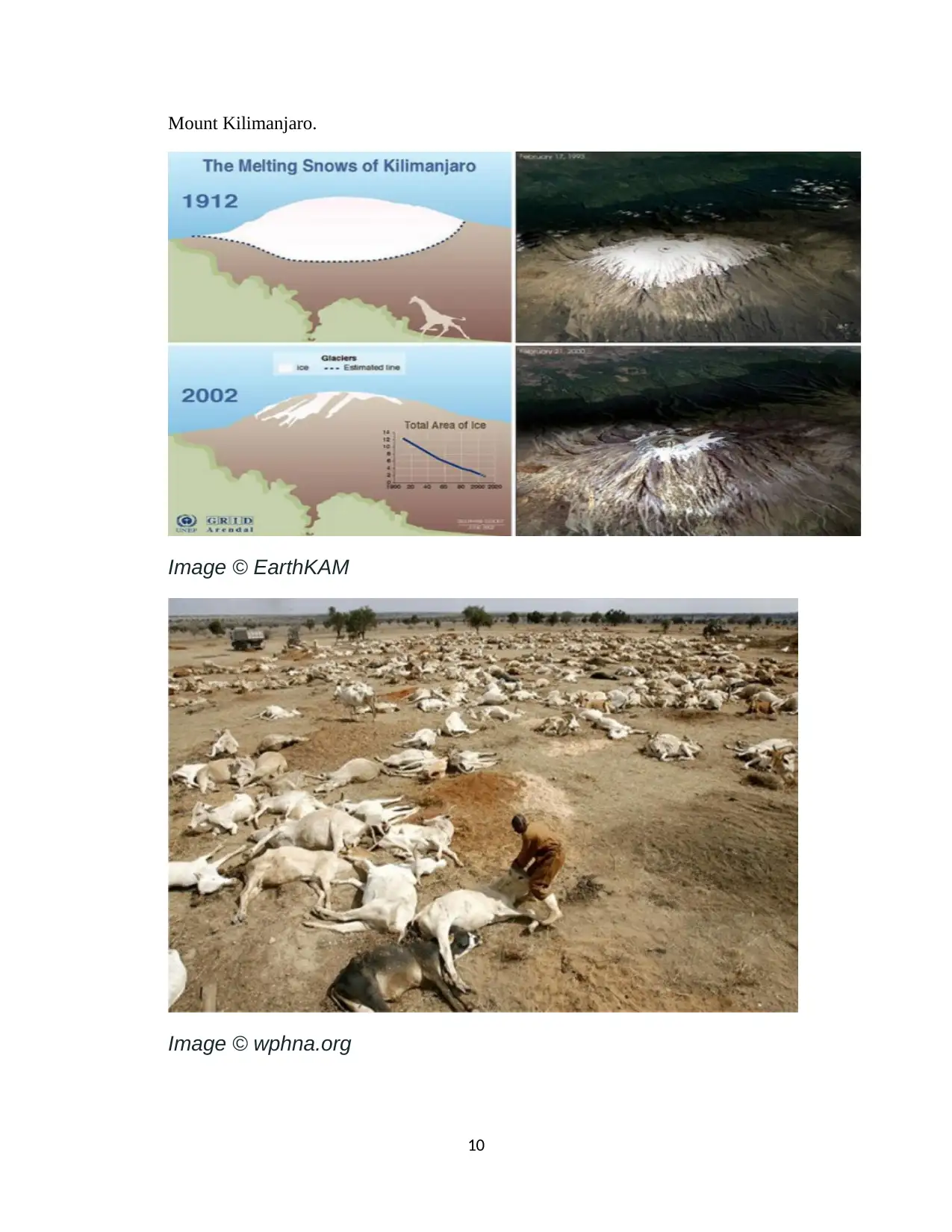
Mount Kilimanjaro.
Image © EarthKAM
Image © wphna.org
10
Image © EarthKAM
Image © wphna.org
10
Paraphrase This Document
Need a fresh take? Get an instant paraphrase of this document with our AI Paraphraser
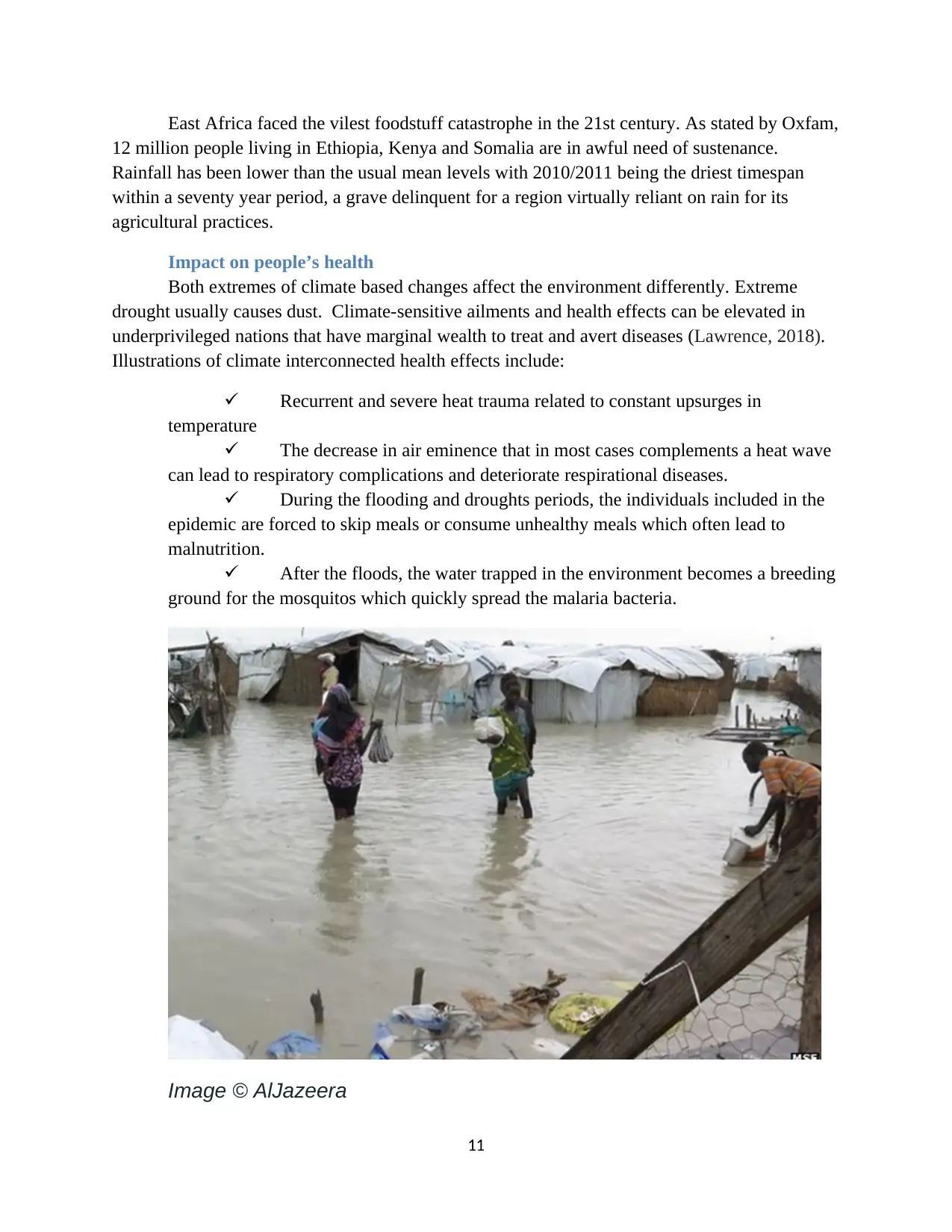
East Africa faced the vilest foodstuff catastrophe in the 21st century. As stated by Oxfam,
12 million people living in Ethiopia, Kenya and Somalia are in awful need of sustenance.
Rainfall has been lower than the usual mean levels with 2010/2011 being the driest timespan
within a seventy year period, a grave delinquent for a region virtually reliant on rain for its
agricultural practices.
Impact on people’s health
Both extremes of climate based changes affect the environment differently. Extreme
drought usually causes dust. Climate-sensitive ailments and health effects can be elevated in
underprivileged nations that have marginal wealth to treat and avert diseases (Lawrence, 2018).
Illustrations of climate interconnected health effects include:
Recurrent and severe heat trauma related to constant upsurges in
temperature
The decrease in air eminence that in most cases complements a heat wave
can lead to respiratory complications and deteriorate respirational diseases.
During the flooding and droughts periods, the individuals included in the
epidemic are forced to skip meals or consume unhealthy meals which often lead to
malnutrition.
After the floods, the water trapped in the environment becomes a breeding
ground for the mosquitos which quickly spread the malaria bacteria.
Image © AlJazeera
11
12 million people living in Ethiopia, Kenya and Somalia are in awful need of sustenance.
Rainfall has been lower than the usual mean levels with 2010/2011 being the driest timespan
within a seventy year period, a grave delinquent for a region virtually reliant on rain for its
agricultural practices.
Impact on people’s health
Both extremes of climate based changes affect the environment differently. Extreme
drought usually causes dust. Climate-sensitive ailments and health effects can be elevated in
underprivileged nations that have marginal wealth to treat and avert diseases (Lawrence, 2018).
Illustrations of climate interconnected health effects include:
Recurrent and severe heat trauma related to constant upsurges in
temperature
The decrease in air eminence that in most cases complements a heat wave
can lead to respiratory complications and deteriorate respirational diseases.
During the flooding and droughts periods, the individuals included in the
epidemic are forced to skip meals or consume unhealthy meals which often lead to
malnutrition.
After the floods, the water trapped in the environment becomes a breeding
ground for the mosquitos which quickly spread the malaria bacteria.
Image © AlJazeera
11
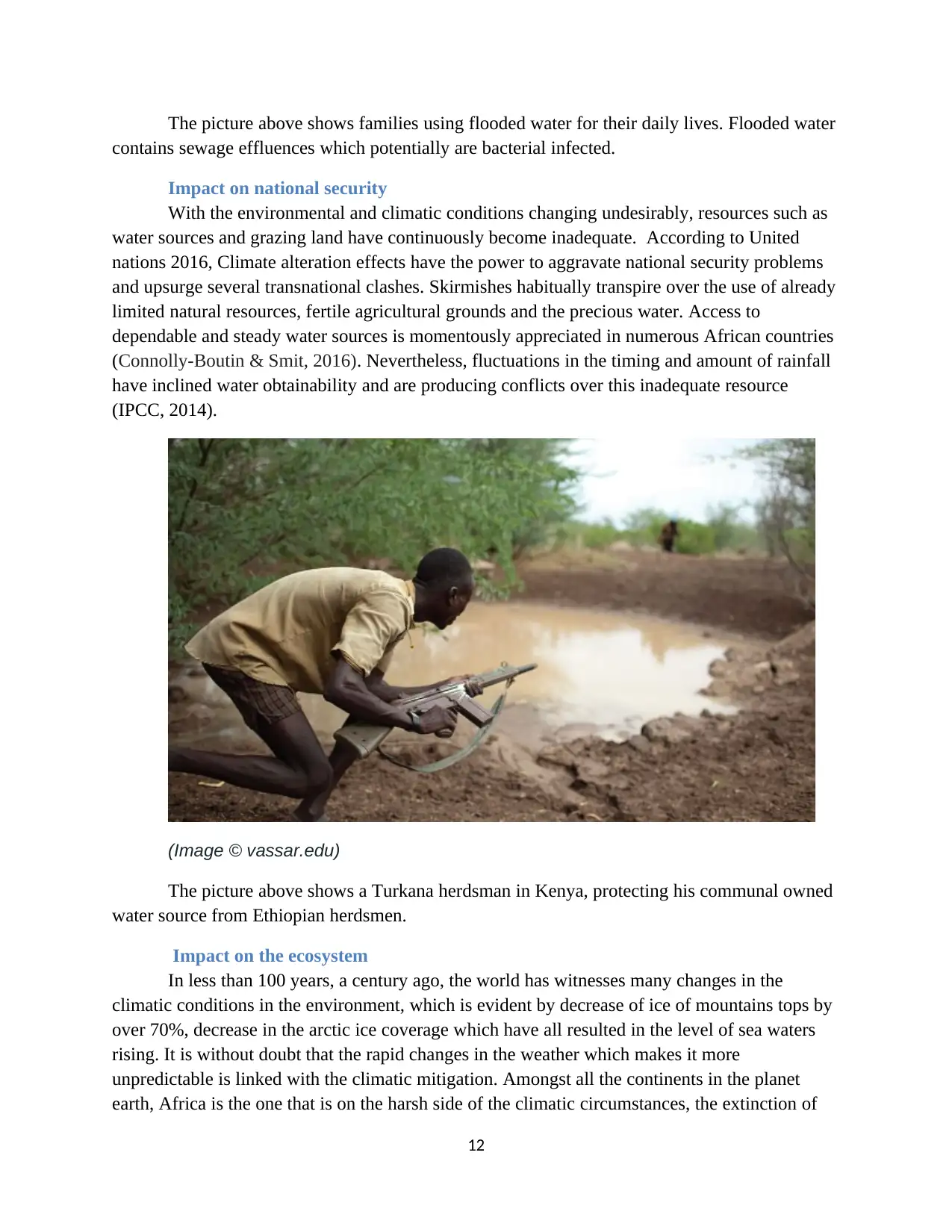
The picture above shows families using flooded water for their daily lives. Flooded water
contains sewage effluences which potentially are bacterial infected.
Impact on national security
With the environmental and climatic conditions changing undesirably, resources such as
water sources and grazing land have continuously become inadequate. According to United
nations 2016, Climate alteration effects have the power to aggravate national security problems
and upsurge several transnational clashes. Skirmishes habitually transpire over the use of already
limited natural resources, fertile agricultural grounds and the precious water. Access to
dependable and steady water sources is momentously appreciated in numerous African countries
(Connolly-Boutin & Smit, 2016). Nevertheless, fluctuations in the timing and amount of rainfall
have inclined water obtainability and are producing conflicts over this inadequate resource
(IPCC, 2014).
(Image © vassar.edu)
The picture above shows a Turkana herdsman in Kenya, protecting his communal owned
water source from Ethiopian herdsmen.
Impact on the ecosystem
In less than 100 years, a century ago, the world has witnesses many changes in the
climatic conditions in the environment, which is evident by decrease of ice of mountains tops by
over 70%, decrease in the arctic ice coverage which have all resulted in the level of sea waters
rising. It is without doubt that the rapid changes in the weather which makes it more
unpredictable is linked with the climatic mitigation. Amongst all the continents in the planet
earth, Africa is the one that is on the harsh side of the climatic circumstances, the extinction of
12
contains sewage effluences which potentially are bacterial infected.
Impact on national security
With the environmental and climatic conditions changing undesirably, resources such as
water sources and grazing land have continuously become inadequate. According to United
nations 2016, Climate alteration effects have the power to aggravate national security problems
and upsurge several transnational clashes. Skirmishes habitually transpire over the use of already
limited natural resources, fertile agricultural grounds and the precious water. Access to
dependable and steady water sources is momentously appreciated in numerous African countries
(Connolly-Boutin & Smit, 2016). Nevertheless, fluctuations in the timing and amount of rainfall
have inclined water obtainability and are producing conflicts over this inadequate resource
(IPCC, 2014).
(Image © vassar.edu)
The picture above shows a Turkana herdsman in Kenya, protecting his communal owned
water source from Ethiopian herdsmen.
Impact on the ecosystem
In less than 100 years, a century ago, the world has witnesses many changes in the
climatic conditions in the environment, which is evident by decrease of ice of mountains tops by
over 70%, decrease in the arctic ice coverage which have all resulted in the level of sea waters
rising. It is without doubt that the rapid changes in the weather which makes it more
unpredictable is linked with the climatic mitigation. Amongst all the continents in the planet
earth, Africa is the one that is on the harsh side of the climatic circumstances, the extinction of
12
⊘ This is a preview!⊘
Do you want full access?
Subscribe today to unlock all pages.

Trusted by 1+ million students worldwide
1 out of 20
Your All-in-One AI-Powered Toolkit for Academic Success.
+13062052269
info@desklib.com
Available 24*7 on WhatsApp / Email
![[object Object]](/_next/static/media/star-bottom.7253800d.svg)
Unlock your academic potential
Copyright © 2020–2025 A2Z Services. All Rights Reserved. Developed and managed by ZUCOL.